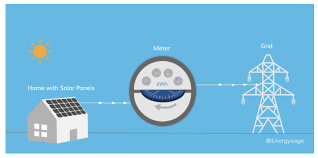
Net metering (also known as net energy metering) is a utility rate program. Your electric company must purchase excess solar energy that your solar panels produce at full-retail electricity rates.
If your solar energy system produces more power than your home uses, it sends the excess to the grid. Your utility then pays you for the extra electricity. Rooftop solar panels are a great way for you to save money. The best places to install solar are not the ones with the highest amount of sunshine. It’s the ones that have the best net-metering policies.
Let’s look at net metering and how it can help you get more money in your pocket.
What is net metering?
Net metering is a credit system that allows you to return solar electricity to the grid. It also offsets the electricity you use from the utility in the future. This gives you the economic value of the solar energy you produce. You can eliminate any monthly electricity costs if your solar system has been properly sized.
When the sun shines in the middle of the day, solar panels produce the most electricity. The problem is that the middle of the afternoon happens to be when you use the most electricity. Your panels are producing way more electricity than your home needs.
The excess electricity generated by solar panels is sent to the grid when it produces more electricity than the home uses. Net metering is used to manage excess generation. Your utility will credit your account for the full retail price of solar energy when a net-metered system sends it to the grid.
When the solar panels stop producing electricity at night, you pull power from the grid and spin your electric meter backward. The utility then calculates the difference between how much electricity you have sent to the grid and how much you used in determining your final bill at the end of each billing period. This is net metering.
Our net metering credits transferable from month to month
It all depends on the utility. However, most full-retail net billing programs allow energy credits for transfer from month to month. If you produce more electricity than you use in a given month, excess net metering credits may be used to offset the electricity taken from the grid for the following month.
You’ll usually have more credits during the summer months when the days are longer and sunnier. These summer credits can reduce your electric bill in the winter.
The true-up policy of your utility, which is how often they buy credits out, will determine how credits can be carried over from month to month. This policy can be found within their net metering policy.
What are the advantages of net metering
Utility bill savings
Net metering is a great option for solar homeowners because it saves them money on their utility bills. Over the life of your solar panel system, net metering could save you thousands of dollars.
Solar panel systems can be used to offset the entire cost of solar customers’ electricity use within a billing cycle, as we have already mentioned. But, electric bills are subject to fixed charges that net meters cannot eliminate.
Payback periods are shorter.
The payback times for areas that offer full retail net meters will be shorter than those that don’t. Because solar homeowners will save more on their electricity bills and recoup their investment costs quicker, this is why they are so popular.
A solar power system installed in New Jersey could payback in 4 to 5 years. This is due in large part to net-metering. It could take 12 years for a system in South Dakota to pay off, as the state does not have any form of net metering.
Your solar payback time is not just affected by net metering. The length of the payback period will depend on many factors, including the size of your photovoltaic systems, how much electricity you use, and the rebates and incentives available in your region.
This reduces the grid’s stress.
Because residential solar panels reduce stress on the electric grid distribution network, utilities and customers reap the benefits. Solar homeowners don’t draw power directly from the grid but instead use their electricity.
Additionally, if a solar system generates more energy than is needed, it can be used by non-solar customers to provide electricity for their energy needs. This reduces the load on utility power plants.
